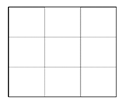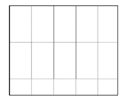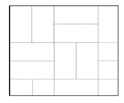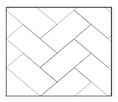Abstract
Concrete block pavement is used as a modern pavement type owing to its economic benefits. The physical properties, mechanical properties, and functional characteristics of bedding sand and joint sand, the main components of concrete block pavements, should be accurately understood. Owing to the discontinuous structure of these pavements, load transfer efficiency (LTE) is the most important index from the perspective of performance. The factors that affect LTE are bedding sand (type, grading, and thickness), joint sand (type and grading), and concrete block (shape and pattern). Therefore, the optimal design for concrete block pavements can be achieved by analyzing each factor. In this study, three types of sand (river, quartz, and manufactured) were selected to examine the mechanical properties via direct transfer experiments. It was observed that the shear strength of river sand was the highest. It was also found that the difference between the shear strength and the internal friction angle (according to the content of 0.6 mm in the grading of bedding sand) was not large, and the shear strength and the friction angle increased as the content increased to 0.075 mm. In addition, the load transfer characteristics of the joint and rotational interlocking of the block were evaluated through a non-destructive test using the degree of joint filling, block shape, and construction pattern as variables. As a result, the degree of joint filling had the greatest effect on the load transfer characteristics of the joint and rotational interlocking of the block. The effect of the block shape was larger than that of the construction pattern. When a heavy load is applied, the LTE between blocks must be maintained at 50% or more, and the rotation of blocks at 0.6° or less, if 75% or more of the joint must be filled for preventing excessive vertical deformation.
1. Introduction
As a modern pavement type, concrete block pavements are widely used in roads, ports, and airports due to their excellent economic efficiency [1,2]. Unlike general asphalt or concrete pavements, individual blocks are used on the surface of concrete block pavement and constructed in a certain pattern to create a discontinuous surface. The block itself should be viewed as a single structure, rather than assuming that it should resist the load of vehicles and ordinary wear [3]. Concrete block pavement is constrained using a curb at the end of the finished surface. Usually, to distribute the concentrated load and increase the inter-block load transfer, blocks are placed with a 2–5 mm spacing in between, which is filled with joint sand. In addition, bedding sand is used in the bedding layer beneath the concrete blocks to ensure the flatness of the concrete block pavement and mitigate the concentrated stress. Depending on the block thickness, construction pattern, and joint width, 40–50% of traffic loading is transferred to the bottom of the pavement [4].
To increase the interlocking effect between blocks and provide a level surface at the bottom, the bedding layer of concrete block pavement is used to fill the empty space at the bottom of the joint to minimize damage caused by the concentrated load. It also levels the lower layer of the concrete block pavement and its finished surface [5]. The thickness of the bedding layer is set to 20–50 mm. The bedding sand layer of a concrete block pavement is not used to secure the bearing capacity, but to make the base and surface layer level with each other. However, when used in a roadway, the bedding sand layer may be crushed by repeated traffic loading, thus affecting the performance of the concrete block pavement. The thicker the bedding layer is, the higher the probability of rutting [6]. Depending on the pavement hierarchy, the requirements of the median particle diameter (600 μm) and fine powder content (75 μm or less) that determine the particle size of the bedding sand are different [7]. The bedding sand, having a low crushing resistance to an external load, is compacted and turned into powder; this reduces the friction between the block and bedding layer, causing the blocks to slide, which leads to the loss of joint sand. Owing to the enlarged joint width, the load transfer efficiency decreases between blocks. When rainwater infiltrates, fine powder of the bedding sand is lost, resulting in damaged concrete block pavement [8]. Beaty (1996) examined the difference in the durability of bedding sand using different rock types through the Lilley and Dowson experiment and found that silica sand was the most durable, followed by granite and limestone. Bedding sand can be evaluated in two ways: properties of sand and properties of materials with reasonable grading [9]. The larger the particle size, the higher the shear resistance, and the better the pavement performance is [10].
Joint sand is one of the components of the surface layer of concrete block pavement that promotes the load transfer between blocks and distributes the concentrated load. Horizontal interlocking between blocks directly affects the structural strength against horizontal load, depending on the joint material, joint width, block shape, and construction pattern, and exhibits the load transfer between blocks [11]. According to the Japan Interlocking Block Pavement Engineering Association (JIPEA), the load transfer characteristics between blocks are evaluated by measuring the load transfer efficiency (LTE) [12].
In addition, the degree of the filling of the joint sand is a very important factor in expanding the stress area at the bottom of the pavement and minimizing the spalling that occurs when angled portions of adjacent blocks collide with each other directly due to external impact.
According to the previous literature, a homogeneous, well-filled joint 2–3 mm wide is required to achieve the optimal load distribution [13]. The rotation of the block due to an external load causes “arching thrust” and provides a high load-bearing capacity through additional rotation suppression of the constraint conditions [14]. Muller et al. (2006) studied the amount of deflection and stress distribution of block pavement according to the joint width, finding that the amounts of deflection in 2 mm and 5 mm joint widths were similar and the stress dispersion was effective when the width was 2 mm [15]. In addition, as the number of compactions increases, the load transfer efficiency and joint width increases, and the joint sand should have a larger maximum particle diameter [16].
It turns out that the loss of joint sand is the main cause of high deflection, broken blocks, and block movement. Among others, it is seen as a decisive factor in the movement of blocks [17]. Yaginuma (2003) used a light falling weight deflectometer (LFWD) to evaluate the LTE of joints for examining the difference in bearing capacity of concrete block pavements according to block dimensions [18]. The load was imposed at the block center to compare the deflection that occurred at the block joint to that of the load directly applied to the adjacent block.
According to advanced research, the role of sand in concrete block pavement design has been defined, which is shown in Figure 1 from the perspective of LTE.
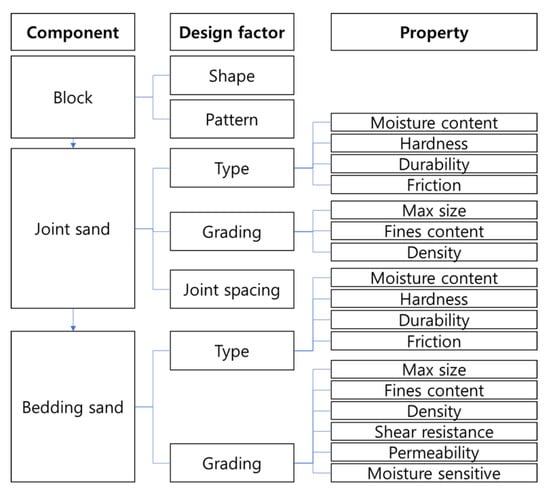
Figure 1.
Role and requirements of sand in concrete block pavement design.
The basic physical properties of sand to be evaluated include moisture content, water absorption, durability, hardness, and friction between particles. The particle size distribution of bedding sand reflects the traffic load conditions, bedding layer thickness, and bedding material density. Density determines the shear resistance, permeability, and moisture sensitivity of a material. When using joint sand, it is important to know not only how the shear resistance resists traffic loading, but also whether it is well filled in the gaps to facilitate an effective load transfer between blocks. Therefore, in this study, composition analysis by sand type and shear resistance according to the grading of bedding sand were evaluated. In addition, the load transfer characteristics and the rotational interlocking effect between blocks according to the degree of joint filling were evaluated using a non-destructive method.
2. Materials and Experimental Methods
2.1. Material
2.1.1. Sand
Three types of sand were selected to evaluate their properties: manufactured sand, quartz sand, and river sand. Table 1 summarizes their basic physical properties. The measured bulk density and absorption of the three materials are similar. The time flow method (JTG E42-2005) was used to measure the sand angularity. River sand was expected to have a low angularity due to water erosion, but the opposite was found. Although the difference was not large, river sand had the highest angularity, while quartz sand and manufactured sand had similar angularities. Regarding the sand equivalent, manufactured sand contained the smallest amount of foreign matter, followed by river sand and quartz sand. The hardness was measured according to JTG E42-2005. To evaluate the hardness of the fine aggregates as a percentage, sand was repeatedly immersed in sodium sulfate liquid and dried before mass changes were measured.

Table 1.
Basic physical properties of sand.
The experimental parameters to evaluate the hardness by sand type and particle size include types of sand, 0.6 mm passing ratio (20%, 40%, and 60%), and 0.075 mm content (1%, 3%, and 5%). An analysis was carried out on the joint material, bedding sand, and material of the water-permeable course. Figure 2 shows the particle size distribution. The particle sizes of the bedding sand and joint sand met ASTM C 33 and ASTM C 144, respectively.
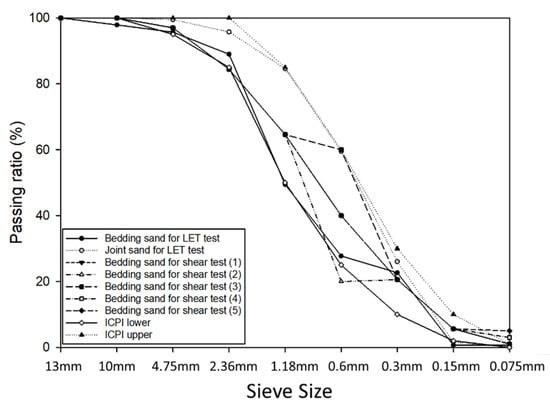
Figure 2.
Distribution of particle sizes of bedding sand and joint sand.
2.1.2. Concrete Block
Table 2 lists the experimental parameters used to examine the load transfer characteristics of the concrete block pavement. Experiments were conducted on 10 cases in total and 4 block shapes were selected. Only the stack pattern was applied to the square blocks, while the stack, basket weave, and herringbone patterns were used for rectangular, Uni, and Dasuri blocks. The block dimensions were normalized using the method proposed by Yaginuma et al. (2003) and defined by a shape factor (Sf), the ratio of the side area to the surface area of the block. The larger this value, the higher the LTE is between blocks (Yaginuma et al., 2003). To maintain constant joint widths, all the blocks used in the experiment were manufactured to have 2 mm protrusions on the side. The flexural strength test of the blocks was measured using the three-point loading method according to KS F 4419. The dynamic modulus was evaluated according to KS F 2437. Table 3 presents the basic properties of the block shapes.

Table 2.
Block shapes and patterns for joint performance evaluation.

Table 3.
Physical properties by block shape.
2.2. Experimental Methods
2.2.1. Bedding Sand Performance
Depending on the thickness and detailed structure of sand, particle size directly affects the physical and mechanical properties of synthesized sand. The content of small particles, in particular, greatly influences the porosity and moisture content of the synthetic material. The experimental parameters used to evaluate the mechanical performance by sand type and particle size include sand type, 0.6 mm passing ratio, and 0.075 mm content. For the experiments, the direct shear test method as per KS F 2343 was used.
2.2.2. Load Transfer and Rotational Interlocking
To evaluate the load transfer performance and rotational interlocking effect of the joint, a test pavement was fabricated, as shown in Figure 3. Its dimensions were 1450 mm × 1450 mm, consisting of an 80 mm surface block, a 30 mm bedding sand layer, a 200 mm crushed aggregate base course, and a 300 mm subgrade layer. To measure the load and displacement, Tokyo Sokki’s LFWD and displacement sensors were used. The experiment was conducted by arranging the LFWD and sensors as shown in Figure 4; a weight of 5 kg was dropped from a height of 500 mm and a load of 20 kN was applied. Concrete block shapes, lying patterns, and degree of joint filling were considered as parameters for the experiment. The degree of joint filling was divided into five stages: 0%, 25%, 50%, 75%, and 100%. The LTE was calculated by multiplying the correction factor with the ratio of the deflection measured in D2 and D1, as shown in Equation (1) presented by AASHTO. The rotational interlocking of the concrete block pavement was calculated by Equation (2) using the displacement that occurred at the position where the load was applied and at the opposite end. Data were collected by measuring each parameter 20 times and were averaged to produce the resulting value.
where LTE is the load transfer efficiency (%); is the rotation angle of the concrete block; is the deflection (mm) measured at the position where the load is applied; is that measured at D1, is that measured at D2; is the distance (mm) between D1 and D0; and is that between D2 and D0.
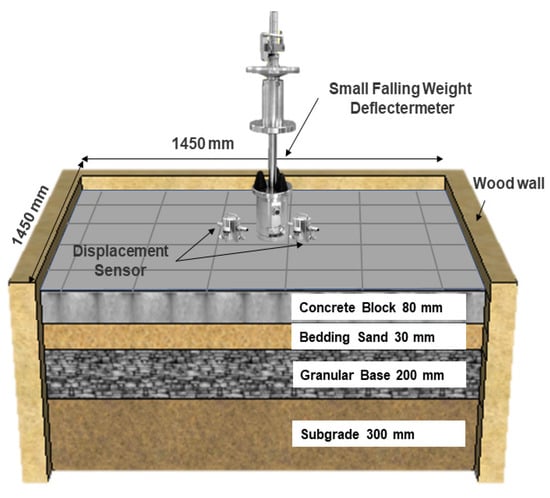
Figure 3.
Pavement sections and experimental setup.
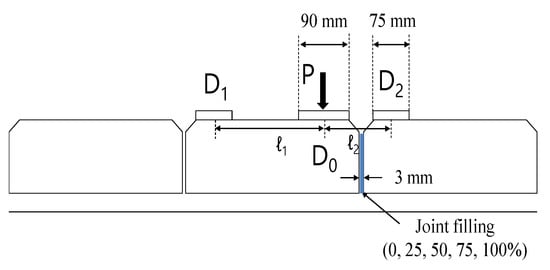
Figure 4.
Method of measuring the LTE and concrete block rotation.
3. Results
3.1. Performance of Bedding Sand
The results of the mechanical performance evaluation according to sand type and particle size are summarized in Table 4. It was found that as the vertical stress increased, the shear strength of all sands increased accordingly, and that of the river sand was the highest. At a vertical stress of 150 kPa, the shear strength of river sand was measured to be approximately 5% and 13% higher than the shear strengths of quartz sand and manufactured sand, respectively. Evaluating shear strength and internal friction angle according to the 0.6 mm passing ratio, it is seen that the difference in shear strength was not large for the river sand, but the shear strength at the 40% passing ratio was the highest. The evaluation of shear strength and internal friction angle, according to the 0.075 mm content of river sand, showed that the larger the 0.075 mm content is, the greater the shear strength.

Table 4.
Shear strength and internal friction angle according to sand type.
3.2. Evaluation of Joint Performance
3.2.1. Load Transfer Characteristics of Joint
The LTE is evaluated by means of FWD at joints in joined concrete pavements or cracks in continuously reinforced concrete pavements. For concrete block pavements, discontinuity is obtained through the joint sand filled between block elements with relatively small dimensions. In general, the diameter of the widely used loading plate of FWD is 300 mm, which is difficult to apply to concrete block pavements; therefore, the load transfer characteristics at joints have not been studied sufficiently. Therefore, we evaluated the load transfer characteristics of joints using a 90 mm loading plate. Manufactured sand was used for the experiment.
First, the difference in load transfer characteristics was examined when the four selected blocks were laid in a stack pattern. Figure 5 shows the LTE by block shape for the stack pattern. It was found that the LTE increased in all block shapes as the degree of joint filling increased, and the minimum difference between 0% and 100% joint filing was approximately three times. When the joint sand was 100% filled, the Uni and Dasuri blocks showed similar load transfer performance, which was approximately 5% higher than that of the square and rectangular blocks. Figure 6 shows the relationship between the shape factor and LTE: a proportional relationship is seen. It can be seen that the load transfer characteristic between blocks is affected a bit by the block shape, but it is significantly affected by the degree of filling of the joint sand.
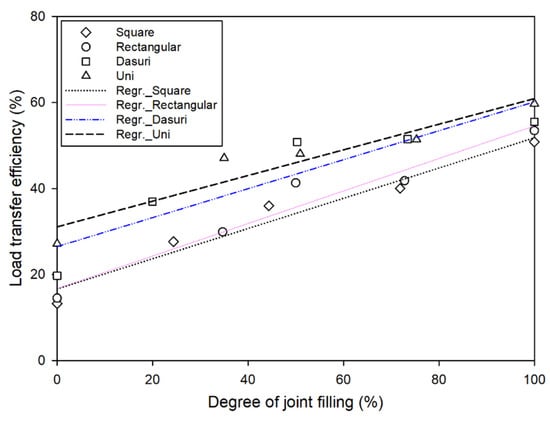
Figure 5.
LTEs by block shapes.
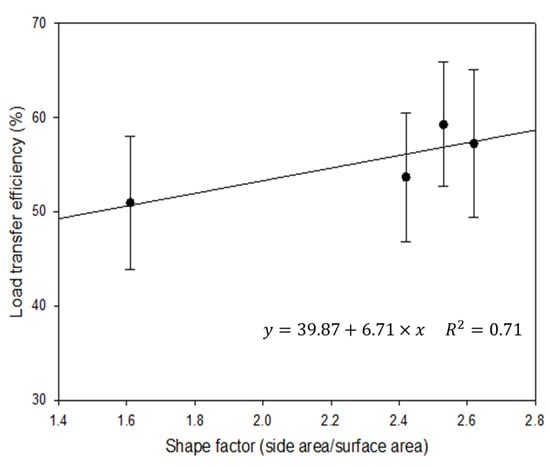
Figure 6.
Relationship between LTE and shape factor (joint filling = 100%).
Figure 7 shows the LTE measurements of the rectangular blocks according to construction pattern. The slope of the linear regression trend line was similar in all cases. A slight difference in the LTE by the construction pattern is measured. LTE is determined according to the joint condition. Since the construction pattern is independent of the joint condition, it is determined not to have an effect on the LTE.
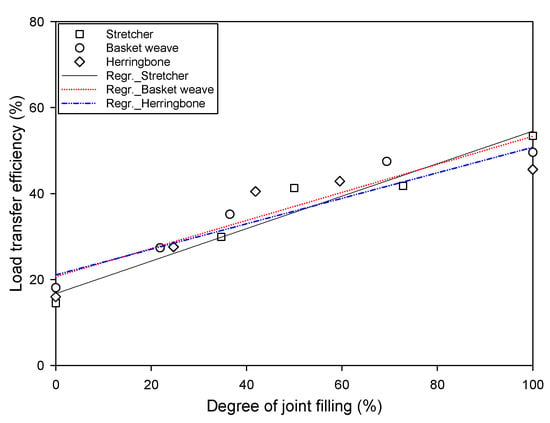
Figure 7.
LTE according to lying patterns for the rectangular block.
According to a study by Ascher et al. (2006), high vertical deformation occurs when the degree of joint filling is less than 75%, whereas high horizontal deformation occurs when it is 0% [19]. If the joint is fully filled, the block thickness and bedding material have no impact on the deformation resistance of the concrete block pavement. Figure 8 shows the LTE if the degree of joint filling is the only parameter regardless of the block shape and lying pattern. A linear regression analysis showed a regression coefficient of 0.68, indicating a correlation. According to Ascher et al. (2006), if the degree of joint filling is 75% or more, the required LTE is approximately 50% or higher [19]. If more than 25% of the joint sand is lost, maintenance is needed to ensure the performance of the concrete block pavement.

Figure 8.
LTE according to the degree of joint filling.
3.2.2. Rotational Interlocking of Block
The load is distributed in the vertical and horizontal directions at the point where the load is applied owing to interlocking between blocks. In this case, the larger the force distributed in the vertical direction is, the greater the block rotation. Rotational interlocking effects based on the block shape were compared only when the blocks were laid in a stack pattern. Figure 9 shows the rotation angles based on the block shapes and degrees of joint filling. Depending on the degree of joint filling, the rotation angles of the blocks decrease linearly, and when 100% of the joint is filled the rotation angles appear to converge between 0.6 and 0.7°. In addition, as the change in rotation angle according to the degree of joint filling is small for U-shaped blocks and Dasuri blocks, it is expected that they will contribute to stable pavement performance if laid in areas where the joint sand loss is likely.
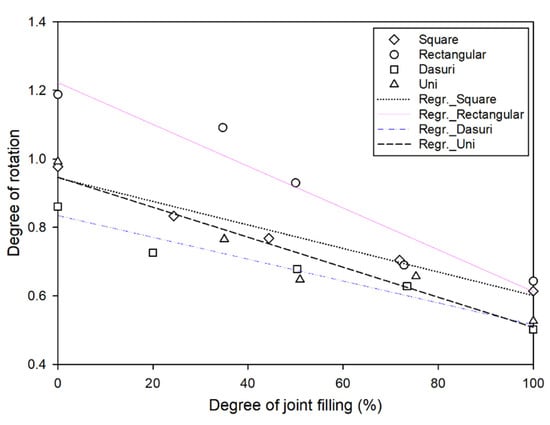
Figure 9.
Rotational angles according to block shape and degree of joint filling.
Figure 10 shows the relationship between the shape factor and the rotation angle, which is found to be inversely proportional. This suggests that the rotational interlocking of a concrete block pavement is influenced by the block shape. In Figure 11, the change in the rotation angle depending on the degree of joint filling is seen to be the greatest in the stack pattern. It appears that the basket weave and herringbone patterns have a similar change in gradient, and the change in rotation angle is small. In addition, the rotation angle according to the block construction pattern and degree of joint filling is initially in the range of 1.0–1.2° depending on the block shapes or construction patterns, but it converges to approximately 0.6° if the joint filling is 100%. This indicates that the degree of joint filling has a greater influence on the rotation angle of a concrete block pavement than block shapes and lying patterns. Similar to the load transfer characteristics, rotational interlocking also has a greater impact on the degree of filling of joint sand than the other two. Figure 12 shows the rotation angles by placing a parameter only on the degree of joint filling regardless of the block shape and lying pattern. A linear regression analysis shows a regression coefficient of 0.61; when 75% or more of the joints were filled, the rotation angle of the block was not significantly different from when 100% of the joints were filled. Therefore, if the joint is required to be filled 75% or more, the rotation of the block must remain at 0.6° or below. This means that if the joint is not filled or interlocking forms between blocks, the rotation should not exceed 0.6°.
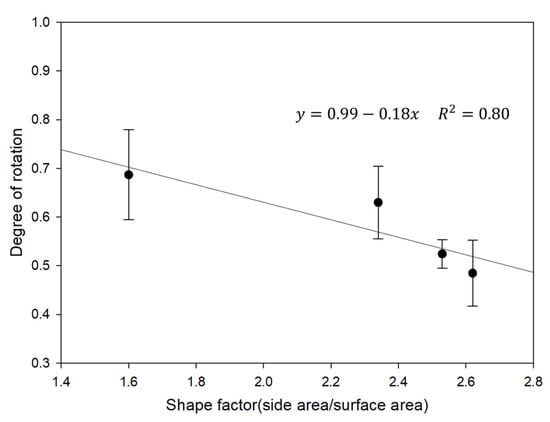
Figure 10.
Relationship between rotation and shape factor (joint filling = 100%).
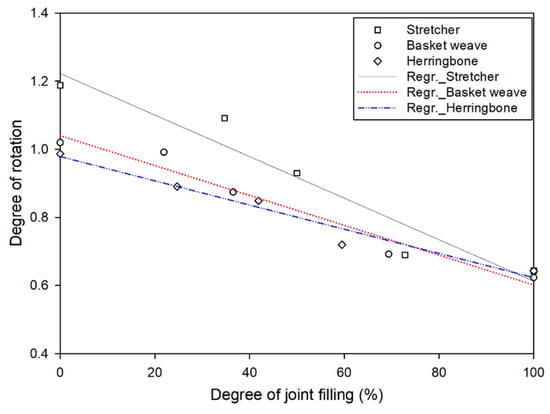
Figure 11.
Rotational angles according to lying pattern and degree of joint filling.
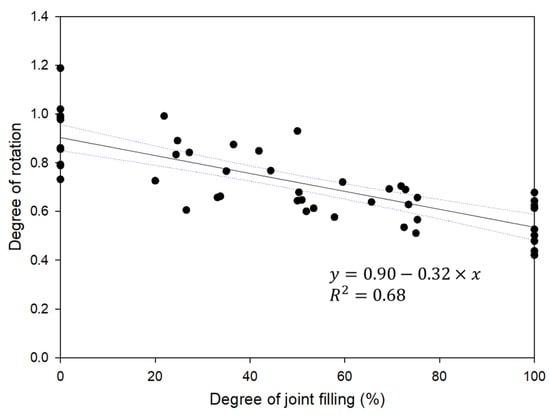
Figure 12.
Rotational angles according to degree of joint filling.
4. Conclusions
In this study, we proposed LTE as the best indicator of concrete block pavement performance. To evaluate the joint and bedding sand, the material properties that affect LTE were measured. The LTE and interlocking effects of concrete block pavements were also assessed.
The load transfer characteristics and rotational interlocking effects were measured using a non-destructive method based on the degree of joint filling, block shape, and construction pattern.
According to the results, the shear strength of the river sand was the highest. A review of bedding sand particle sizes showed that, in the evaluation results of the internal friction angle and shear strength according to the 0.6 mm content, the difference in shear strength was not significant. It was found that the shear strength and friction angle of the material increased as the 0.075 mm content increased.
It appeared that, in all block shapes, the greater the degree of joint filling was, the greater the LTE; the rotation was smaller, which generated a strong interlocking effect. Based on these limited test results, LTE and rotation were compared according to the block shape and pattern. For each experiment, joint filling was used as the variable. The higher the LTE and smaller the rotation, the better the performance was of the block pavement. Depending on block shape, LTE can be improved by approximately 15% and the degree of rotation is approximately 20% different. However, we believe that the LTE pattern has a negligible effect. In the case of rotation, the difference according to the pattern is also limited when the joint filling is very low. Depending on the variables, joint filling improves the LTE performance by more than 30% and rotation performance by 25%. Therefore, to derive the optimal performance of the block pavement, it is recommended to use a block with a high shape factor and fill 100% of the joint.
In this study, LTE and degree of rotation were proposed as major performance indicators of block pavement. Additionally, factors related to performance were reviewed. The research results of measuring the performance change of block pavement according to variables through experiments can be used for block pavement design. In addition, it was possible to suggest the conditions under which block pavement can exhibit optimal performance. In the future, changes in LTE according to joint spacing, types of joint sand and bedding sand, and performance according to grading should be studied.
Author Contributions
Conceptualization, W.L. and Y.-h.C.; methodology, Y.-h.C.; software, W.L.; validation, W.L. and Y.J.; investigation, Y.D.; resources, H.Z.; data curation, Y.J.; writing—original draft preparation, W.L. and Y.D.; writing—review and editing, W.L. and Y.J.; visualization, Y.D.; funding acquisition, H.Z. and Y.J. All authors have read and agreed to the published version of the manuscript.
Funding
This research was supported by the National Natural Science Foundation of China (No. 51808334) and the Korea Institute of Civil Engineering and Building Technology Research Project (No. 20210140-001).
Conflicts of Interest
The authors declare no conflict of interest.
References
- Gunatilake, D.; Mampearachchi, W.K. Finite element modelling approach to determine optimum dimensions for interlocking concrete blocks used for road paving. Road Mater. Pavement Des. 2019, 20, 280–296. [Google Scholar] [CrossRef]
- Talesnick, M.; Geller, R. Case study of premature failure of a concrete block pavement system at a shipping container logistics site. J. Perform. Constr. Facil. 2020, 34, 04019093. [Google Scholar] [CrossRef]
- Shackel, B.; Lim, D.O.O. Mechanism of paver interlock. In Proceedings of the 7th International Conference on Concrete Block Paving, Sun City, South Africa, 12–15 October 2003. [Google Scholar]
- Jamshidi, A.; Kurumisawa, K.; White, G.; Nishizawa, T.; Igarashi, T.; Nawa, T.; Mao, J. State-of-the-art of interlocking concrete block pavement technology in Japan as a post-modern pavement. Constr. Build. Mater. 2019, 200, 713–755. [Google Scholar] [CrossRef]
- Anthony, N.S. Predicting the performance of bedding sands. In Proceedings of the 4th International Conference on Concrete Block Paving, Auckland, New Zealand, 16–19 February 1992; pp. 273–284. [Google Scholar]
- Mascio, P.D.; Moretti, L.; Capannolo, A. Concrete block pavements in urban and local roads: Analysis of stress-strain condition and proposal for a catalogue. J. Traffic Transp. Eng. 2019, 6, 557–566. [Google Scholar] [CrossRef]
- Bullen, F.; Knapton, J. Bedding sand permeability and segmental pavements. Road Transp. Res. 1999, 8, 16–27. [Google Scholar]
- Yasuhisa, K.; Ando, Y.; Omoto, S.; Yaginuma, K.; Toriiminami, K. Study on block shifting of interlocking block pavement. In Proceedings of the 8th International Conference on Concrete Block Paving, San Francisco, CA, USA, 6–8 November 2006; pp. 447–456. [Google Scholar]
- Beaty, A.N.S. Laying course materials: Specification and performance. In Proceedings of the 5th International Conference on Concrete Block Paving, Tel Aviv, Israel, 23–27 June 1996; pp. 129–139. [Google Scholar]
- Panda, B.C.; Ghosh, A.K. Structural behavior of concrete block paving. I: Sand in bed and joints. J. Transp. Eng. 2002, 128, 123–129. [Google Scholar] [CrossRef]
- Garilli, E.; Autelitano, F.; Roncella, R.; Giuliani, F. The influence of laying patterns on the behaviour of historic stone pavements subjected to horizontal loads. Constr. Build. Mater. 2020, 258, 119–657. [Google Scholar] [CrossRef]
- Japan Interlocking Block Pavement Design and Construction Manual (JIEPA); Japan Interlocking Pavement Engineering Association: Tokyo, Japan, 2017. (In Japanese)
- Mampearachchi, W.K.; Senadeera, A. Determination of the most effective cement concrete block laying pattern and shape for road pavement based on field performance. J. Mater. Civ. Eng. 2014, 26, 226–232. [Google Scholar] [CrossRef]
- Soutsos, M.N.; Tang, K.; Khalid, H.A.; Millard, S.G. The effect of construction pattern and unit interlock on the structural behavior of block pavements. Constr. Build. Mater. 2011, 25, 3832–3840. [Google Scholar] [CrossRef]
- Muller, R.M.; Motta, L.M.G.; Medina, J. Evaluation of the thickness of joints in transmission of stress and displacements in an experimental panel of ICBP. In Proceedings of the 8th International Conference on Concrete Block Paving, San Francisco, CA, USA, 6–8 November 2006; pp. 411–420. [Google Scholar]
- Panda, B.C.; Ghosh, A.K. Source of jointing sand for concrete block pavement. J. Mater. Civ. Eng. 2001, 13, 235–237. [Google Scholar] [CrossRef]
- Yaginuma, H.; Yoshida, T.; Ikeda, T. Evaluation of durability of bedding sand for interlocking block pavement under repeated loading by heavy vehicles. Doboku Gakkai Ronbunshu 2001, 2001, 267–276. [Google Scholar]
- Yaginuma, H.; Tanaka, M.; Kasahara, A.; Yazawa, S. Development of a standard for block dimensions for use under Japanese conditions. In Proceedings of the 7th International Conference on Concrete Block Paving, Sun City, South Africa, 12–15 October 2003. [Google Scholar]
- Ascher, D.; Lerch, T.; Oeser, M.; Wellner, F. Deformation behaviour of concrete block pavements under vertical and horizontal dynamic load. In Proceedings of the 8th International Conference on Concrete Block Paving, San Francisco, CA, USA, 6–8 November 2006; pp. 457–465. [Google Scholar]
Publisher’s Note: MDPI stays neutral with regard to jurisdictional claims in published maps and institutional affiliations. |
© 2021 by the authors. Licensee MDPI, Basel, Switzerland. This article is an open access article distributed under the terms and conditions of the Creative Commons Attribution (CC BY) license (https://creativecommons.org/licenses/by/4.0/).




